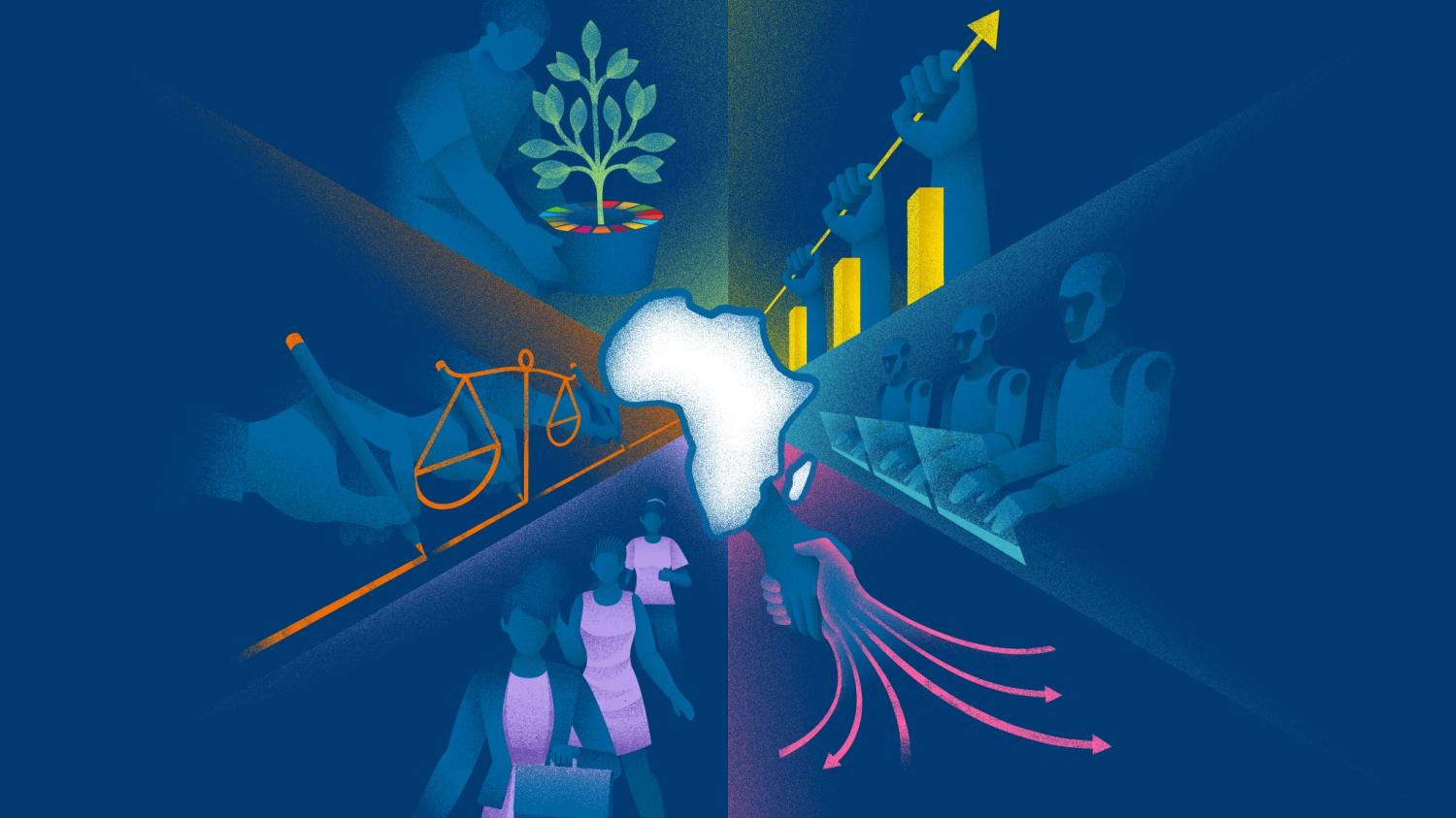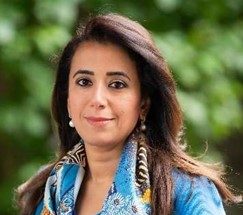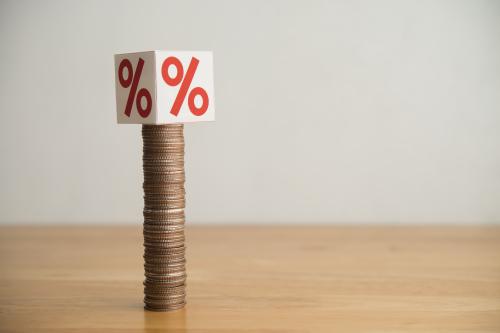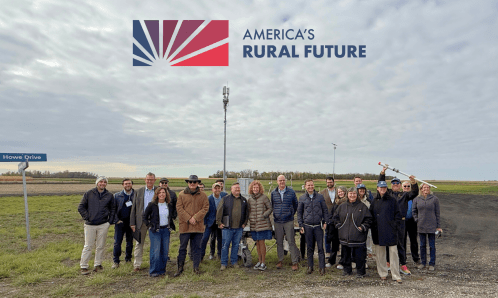This viewpoint is part of Chapter 2 of Foresight Africa 2025-2030, a report with cutting-edge insights and actionable strategies for Africa’s inclusive and sustainable development in the run-up to 2030. Read the full chapter on the Sustainable Development Goals.
While Africa faces a significant financing gap to achieve the SDGs by 2030, innovative financing mechanisms, strategic partnerships, and robust national policies present opportunities to bridge this gap.
The rough patches ahead to meet the SDGs in Africa
Progress toward achieving the Sustainable Development Goals (SDGs) has had a mixed record across the globe. For African countries, steady progress was made until the end of the commodity price supercycle in 2016 then started to decline, a situation precipitated by the COVID-19 pandemic and the war in Ukraine. Since 2023, this trend has reversed. The rest of the world’s experience has been slightly different, with progress on the SDGs having been stalled since the financial crisis of 2008/2009.1 In both cases, even in the best of times, progress toward the SDGs has been dismally inadequate. For example, to achieve the SDGs, as captured by the aggregate SDG index,2 African countries, on average, must grow at a rate of 4% per year. The average annual growth rate in the SDG index achieved by African countries is less than 1%, even at their best. The performance of non-African countries is even worse, with the highest annual growth rate in the SDG index recorded close to 0.6%, much less than the 3% required to meet the SDGs.3
The question before us, therefore, is whether the recent upward trend noticed in Africa could be sustained and accelerated to meet the SDGs by 2030?
Among the several factors required to accelerate progress toward the SDGs, availability of development finance or investment in the SDGs is the most critical. As Africa approaches 2030, the financing gap for achieving the SDGs is vast. According to estimates by UNECA,4 successful implementation of the SDGs would require $1.3 trillion annually, of which it is estimated African countries could mobilize a little over 50%, leaving a huge financing gap. According to the African Development Bank, this gap has been exacerbated by global economic downturns, the COVID-19 pandemic, and climate change-related catastrophes, creating significant pressure on national budgets and development efforts across the continent.5 These challenges coincide with rising public debt in most African countries, making reaching the SDGs by 2030 a daunting task.
Various reports and studies confirm the tight fiscal space in which many African countries currently find themselves leading to a continuous underinvestment in the SDGs. Indeed, countries that have a severe fiscal sustainability gap experienced a decline in the speed of progress toward SDGs, and in some cases a reversal (Figure 10). In addition, some estimates suggest that financial flows to low-income countries targeted to address the SDGs have declined significantly in the wake of recent global shocks.6
Several key challenges hamper the mobilization and effective allocation of financing for the SDGs, both at the national and global levels. First, domestic resource mobilization remains limited, with many African economies struggling with narrow tax bases, tax evasion, and inefficiencies in public financial management.7 While much has been said about the need to increase overall tax mobilization efforts by strengthening state capacity, the differential effect of different sources of tax revenue on the progress toward SDGs has not been adequately addressed. As shown in Figure 11 the larger the share of direct taxes in overall tax mobilization efforts, the greater the chance of achieving the SDGs. This certainly implies progress in growth processes underpinned by structural changes that enhance the share of the formal economy.
On the other hand, the greater the share of taxes emerging from resource extraction, the less effective they become in advancing the SDGs in different parts of Africa. Figure 12 clearly shows the relatively strong and positive relationships between tax revenue generated from resources and the SDGs in North Africa, while a perversive negative relationship in sub-Saharan Africa raises an important concern on the dimmer outlook for the SDGs that rely on simple government revenue mobilizations without the necessary institutional or structural reforms. Moreover, external financing sources, including foreign direct investment, official development assistance, and remittances, are often volatile and insufficient to meet development needs.
Secondly, the high debt burden of many African nations has crowded out public investment in critical sectors such as health care, education, and infrastructure, undermining efforts to achieve the SDGs. Additionally, financing tends to be skewed toward short-term projects, with less emphasis on long-term, sustainable investments that could yield lasting impact. The fragmented nature of global financial flows, coupled with the lack of coherence in policy frameworks, further complicates efforts to align financing with the SDGs.
Opportunities for improving financing composition and allocation
Despite these challenges, several opportunities exist to improve the composition and allocation of financing for the SDGs. Blended finance—the strategic use of public funds to attract private sector investment—holds significant promise for addressing financing gaps.8 By de-risking investments, especially in infrastructure, energy, and agriculture, blended finance can catalyze private capital flows to sectors critical for sustainable development.
Moreover, strengthening public-private partnerships (PPPs) can provide a vital channel for funding large-scale projects, particularly in renewable energy and digital infrastructure, which are crucial for economic transformation. African countries can also leverage innovative financial instruments, such as green bonds, diaspora bonds, and impact investing, to attract diverse pools of capital aligned with the SDGs.
At the global level, aligning international development cooperation with national SDG priorities can foster more efficient resource allocation. Greater coordination among development actors, such as multilateral institutions, donors, and private investors, can ensure that financing is directed toward the most impactful and scalable interventions. It is also important to emphasize the significance and urgency of reforming the global financial architecture with all its ramifications to accelerate Africa’s progress toward the SDGs.
Effective national strategies for SDG investment
Several African countries, such as Ethiopia, Rwanda, and South Africa, have adopted national strategies and policies that have proven effective in facilitating long-term investment in the SDGs that emphasize sustainable industrialization, infrastructure development, and human capital investments, all of which are closely aligned with SDG targets.9 These national strategies prioritize fiscal discipline, attract foreign direct investment, and foster private sector growth, thereby creating an enabling environment for SDG-aligned investments.
Additionally, domestic resource mobilization efforts such as leveraging information technology to improve tax mobilization capacities that include identification, detection, and collection capacity are very important.10 These policies aim to improve tax collection, reduce leakages, and enhance accountability in the management of public resources.
In conclusion, while Africa faces a significant financing gap to achieve the SDGs by 2030, innovative financing mechanisms, strategic partnerships, and robust national policies present opportunities to bridge this gap. By leveraging these solutions, African countries can chart a path toward sustainable, inclusive growth and successful SDG implementation.
-
Footnotes
- “SDG Index,” SDG Transformation Center, June 17, 2024, https://sdgtransformationcenter.org/sdgindex; “Transformation Center,” SDG Transformation Center, accessed December 11, 2024, https://sdgtransformationcenter.org.
- “SDG Index.”; “Transformation Center.”
- “SDG Index.”; “Transformation Center.”
- “Long-Term Financing for Sustainable Development in Africa,” United Nations Economic Commission for Africa, 2020, https://uneca.org/chapter/economic-report-africa-2020/long-term-financing-sustainable-development-africa.
- “$4 Trillion is New Annual Financial Target to Save Sustainable Development Goals, Says African Development Bank’s Adesina,” African Development Bank Group, April 29, 2024, https://www.afdb.org/en/news-and-events/pressreleases/4-trillion-new-annual-financial-target-save-sustainable-development-goals-says-african-development-banksadesina-70346.
- Isabella Massa and Leslie Bermont Díaz, “SDG Financing Needs an Urgent Global Reboot,” in SDG Action, 2023, https:// sdg-action.org/sdg-financing-needs-an-urgent-global-reboot/.
- Logan Wort, “African Countries Must Collaborate to Fix Tax Challenges,” AllAfrica.Com, September 6, 2017, https:// www.proquest.com/docview/1935886956/citation/B8F56E7911D9439DPQ/1.
- “How Blended Finance Works,” IFC, accessed December 11, 2024, https://www.ifc.org/en/what-we-do/sectorexpertise/blended-finance/how-blended-finance-works.
- Helen Hai, “Making Industrialization in Africa Sustainable,” United Nations (blog) (New York: United Nations, December 1, 2020), https://www.un.org/en/un-chronicle/making-industrialization-africa-sustainable.
- Oyebola Okunogbe and Gabriel Tourek, “How Can Lower Income Countries Collect More Taxes? The Role of Technology, Tax Agents, and Politics,” The Journal of Economic Perspectives 38, no. 1 (2024): 81–106, https://doi.org/10.2307/27282175.
The Brookings Institution is committed to quality, independence, and impact.
We are supported by a diverse array of funders. In line with our values and policies, each Brookings publication represents the sole views of its author(s).








Commentary
Navigating rough patches: Financing Africa’s SDGs and the path forward
May 6, 2025